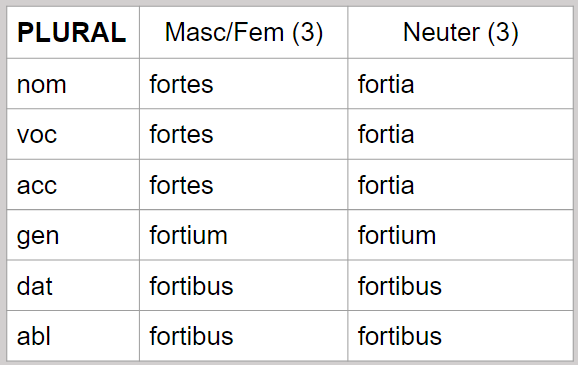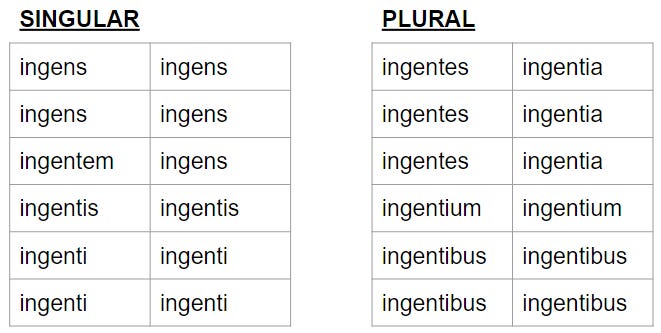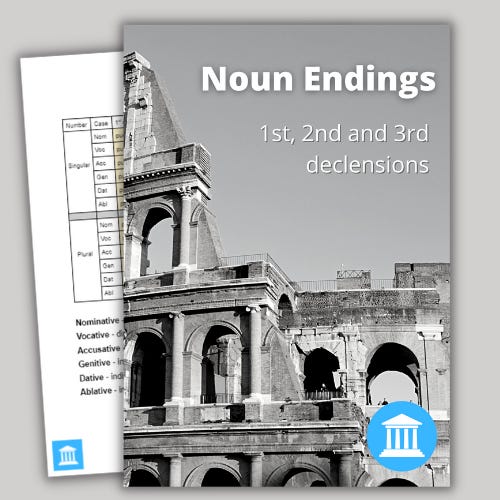Easy 3-3 Adjectives
January Latin Challenge: Day 25 of 31
Today we are going into 3-3 adjectives and why they are so easy!
If you missed yesterday’s post about 2-1-2 adjectives you can find it here in the bambasbat archive: it was Day 24 of the January Latin Challenge.
Why are they called 3-3 adjectives?
To be honest the name actually makes a lot of sense, but to understand it, lets just take a step back for one minute and remind ourselves what adjectives are again.
Adjectives are words that describe nouns. The brave girl, the sad dog, the difficult man and so on. In English, they’re fairly easy, because they just go next to the noun they are describing.
In Latin though, word order doesn’t matter. What matters are endings, and we use these to tell which noun the adjectives are describing. In Latin, adjectives have to match the noun they are describing in 3 ways:
case,
number, and
gender.
This is super important, so remember this phrase.
3-3 adjectives are ones like fortis. Now in your dictionary you might just see it as fortis, or you might see it written like this: fortis forte. This tells me its a 3-3 adjective because it shows what form of the adjective I should use for masculine or feminine nouns (fortis) and which I should use for neuter nouns (forte).
fortis is what you would use to describe a masculine noun or a feminine noun:
fortis dominus
The brave master
fortis femina
The brave woman
There is no difference for these adjectives between masculine and feminine nouns - they describe them both the same way.
forte is for neuter nouns:
forte consilium
The brave plan
A tricky situation
Now this is where we get slightly different from 2-1-2 adjectives, in that often the endings will not look like they match the thing being described. They will match, it just won’t look as easy to match up as laetus servus for example, or laeta puella.
For this, you need to really know the noun endings for the 3rd declension nouns. If you can’t remember, go and download my free Noun Endings Guide - it will really help.
How to match them
Remember that adjectives have to match in case, number, and gender, so our adjective has to change its ending depending on what role the noun it describes is playing.
So, to make your adjective match a masculine noun, like puer, you follow the 3rd declension masculine/feminine column on the table of noun endings (which you can find below).
fortis puer puellam videt.
The brave boy sees the girl.
Here’s where it gets tricky - if fortis can describe masculine or feminine nouns, how do we know the boy is brave, and not the girl?
For this I also need to know how the endings change depending on the case the noun is in. So if I have the sentence above, I use fortis puer - he is masculine, singular, and nominative, and so is fortis.
But if I have this sentence:
puella fortem puerum videt
The girl sees the brave boy
then I use fortem puerum - he is now accusative, so my adjective has to change too.
This is how I know the girl isn’t the brave one - in the second sentence she is nominative, so the adjective doesn’t match her in all three of those things an adjective needs to match: case, number and gender.
Tables time
Here are the endings for the singular and plural forms of fortis.
Just keep an eye on the singular nominatives and accusatives, they’re the ones that change. Also note that the ablative singular does not end in -e as in the noun tables, but -i like the dative. The plurals for the genitive, dative and ablative are the same for either gender group, but the nominative, vocative and accusative are different.
Examples
Let’s have a go at matching adjectives with their nouns. Here are some sentences. Which noun is being described by the adjective (in bold) in each sentence? Remember - word order doesn’t matter in Latin! Have a go yourself, and read on when you’re ready to know the answers.
fortes amicos vidi.
vos feminae sunt fortes hodie.
rex a militibus fortibus servatur.
nos fortia consilia audivimus.
donum forti puellae da!
Read on when ready
fortes is a masculine or feminine nominative or accusative plural.
I know the verb vidi means “I saw”, so I know that I am in charge, I am the nomintaive. That means fortes can’t be describing me, as I am not plural!
So it has to be accusative, which matches amicos - a plural accusative with a masculine gender.
“I saw the brave friends.”
fortes again here is a masculine or feminine ending. In this instance it is a plural nominative. There is no other noun for it to describe, so it matches feminae -
“You women are brave today!”
fortibus is a dative or ablative plural, and it could be either gender group. So I need to look for a dative or ablative plural noun - militibus is the only one, so now I know it describes the soldiers.
“The king is protected by brave soldiers.”
fortia is neuter, but it can’t be nominative as the verb audivimus is being done by “us”, and we are not neuter.
So it must be accusative. It matches with consilia - an accusative plural neuter.
“We heard the brave plans.”
forti again could be several cases.
However, I have the verb da! which is an imperative. “Give the gift” (donum).
So I assume this sentence is telling someone to give the gift TO someone - can I find a dative singular noun? Yes - puellae here is feminine, dative and singular. This is one of the options that forti matches, so I will put them together.
“Give the gift to the happy girl!”
Other 3-3 adjectives
You can’t always just describe things as “brave” or our stories would get very boring. Here are some other examples 3-3 adjectives. There are some oddities in there which I will explain, but just familiarise yourself with these common adjectives.
audax audacis - brave, bold
brevis breve - brief, short
celer (celerem) celere - quick
crudelis crudele - cruel
difficilis difficile - difficult
fidelis fidele - loyal
ingens ingens - huge
tristis triste - sad
Now a couple of these look different. celer for example acts as if the nominative started as celeris and the endings are attached to the whole word celer, rather than taking anything off. Otherwise it follows the patterns.
The other is ingens, which is so important that here is the whole table for ingens.
The main thing to be aware of is that the nominative, vocative and accusatives are the ones that vary depending on gender. The others are exactly the same as fortis and those other adjectives in the list, but it is a common one so I thought I would show you the whole table.
So to round it off, a 3-3 adjective is just the name we give to a group of adjectives that change to match their noun by using the 3rd declension endings for masculine and feminine nouns and the 3rd neuter endings for neuter nouns. If you are struggling at all with these endings, do go and download my free Noun Endings Guide.
And that’s a quick overview of 3-3 adjectives! I hope it helped - let me know if you have questions in the comments, and I’ll see you tomorrow on bambasbat for Day 26 of the January Latin Challenge!





